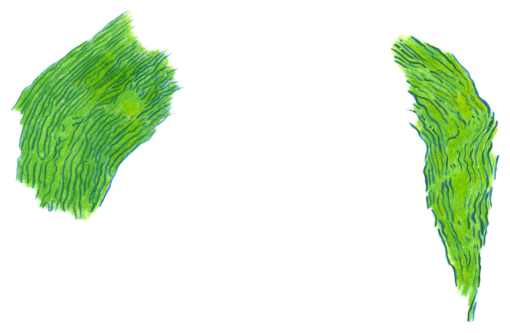Upriver, salmon eggs could be hatching just now. I learn that pimples on the fish’s skin become scales with marks that register their growth pattern, like tree rings. In actuality, these are in life tiny and transparent, but to understand them I draw them large and salmon coloured.

drawing © Kate Foster
The Tweed Foundation collects scales from anglers, and accumulates data that helps interpret seasonal changes in the fishing catch. With a microscope, an expert eye might see that a salmon lived for two winters in the river, with a further winter at sea before returning to the Tweed to spawn. The wider separated bands in the blue drawing (a detail) suggest that this fish made a rapid transition to sea and began to feed well.

drawing © Kate Foster
Sometimes, there are checks in the usual pattern of faster summer growth, where the circuli stay tight and close.

drawing © Kate Foster
Very rarely, a female salmon manages to return to sea after spawning, and runs upriver a second time. The Tweed is a long river, and perhaps only one in a hundred manage this. These fish have scales with spawning marks developing from interrupted growth where scales were consumed, reabsorbed for energy to swim upstream.

drawing © Kate Foster
Typically a spawned salmon, a kelt, will die in the river and the eroded scales will document the exhaustion of the fish’s reserves.

detail of research drawing © Kate Foster
Having learnt something of what can be seen close-up, I needed to take a step back to take this in. A textbook informs me how they deserve their name, ‘Atlantic Salmon’: they are a species who use ocean currents to drift to cold subarctic waters. Rich feeding to the west of Greenland allows them to mature before returning to their home river in mating mood.

detail of research drawing © Kate Foster
Towards the end of this first lesson in scale-reading, our careful tutors say that there is currently speculation about future patterns that will be read in salmon scales. Within ten years perhaps, the north pole will be a navigable ocean, allowing passage to the Pacific.

detail of research drawing © Kate Foster
To reflect on this, I look at recently published papers. With anxiety, I start to draw icebergs on perspex – dotting out the zone that was navigable to ice-hardy ships in 1970. In my drawing the icebergs lessen over time, and tail off at 2100. I wish it was the other way up, and I could draw them more concentrated at the pole, like this:

detail of research drawing © Kate Foster
Scaling the Tweed started with a close-up view, but also is making me look further away.

detail of research drawing © Kate Foster
Acknowledgements and thanks to Tweed Foundation. Any errors text and drawings are my responsibility. The research drawing can be seen in the Robson Gallery in Selkirk (see previous post) until mid May.










 4th April 2013 6.30-8.30pm
4th April 2013 6.30-8.30pm This is a chance to hear firsthand about their experiences in Estonia, how they responded to the impressions and surroundings of MoKS, and more about how the MoKS model works. It’s also an opportunity to discuss how residencies develop artistic practice, and what links we can make now and in the future with international residency programmes. MoKS is set in Mooste – a very rural part of Estonia – and there were many intriguing parallels and differences with respect to the Borders.
This is a chance to hear firsthand about their experiences in Estonia, how they responded to the impressions and surroundings of MoKS, and more about how the MoKS model works. It’s also an opportunity to discuss how residencies develop artistic practice, and what links we can make now and in the future with international residency programmes. MoKS is set in Mooste – a very rural part of Estonia – and there were many intriguing parallels and differences with respect to the Borders.